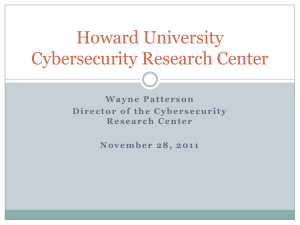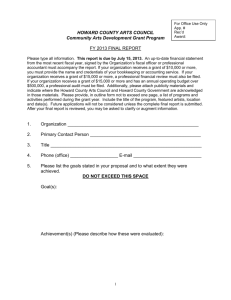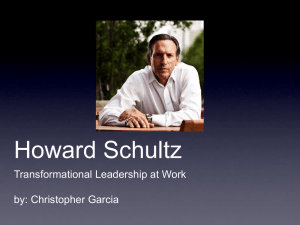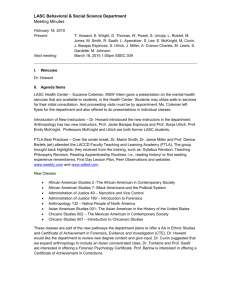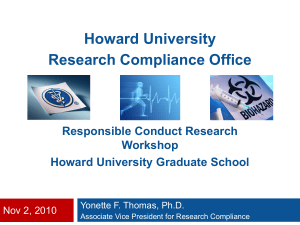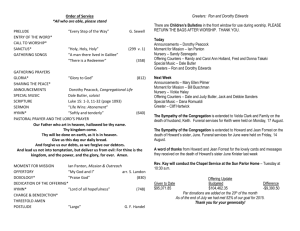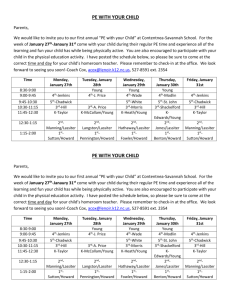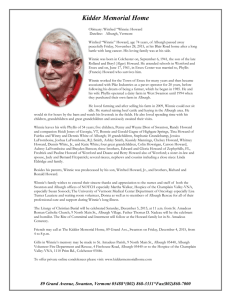Veniamin Gushchin, Marriotts Ridge
advertisement
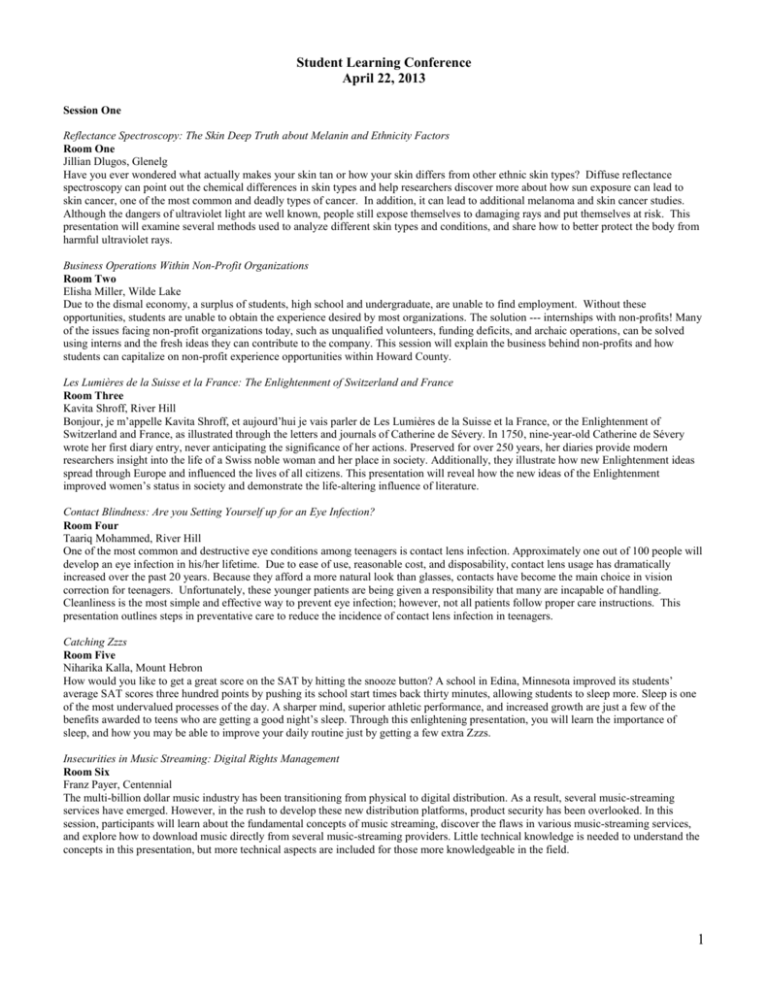
Student Learning Conference April 22, 2013 Session One Reflectance Spectroscopy: The Skin Deep Truth about Melanin and Ethnicity Factors Room One Jillian Dlugos, Glenelg Have you ever wondered what actually makes your skin tan or how your skin differs from other ethnic skin types? Diffuse reflectance spectroscopy can point out the chemical differences in skin types and help researchers discover more about how sun exposure can lead to skin cancer, one of the most common and deadly types of cancer. In addition, it can lead to additional melanoma and skin cancer studies. Although the dangers of ultraviolet light are well known, people still expose themselves to damaging rays and put themselves at risk. This presentation will examine several methods used to analyze different skin types and conditions, and share how to better protect the body from harmful ultraviolet rays. Business Operations Within Non-Profit Organizations Room Two Elisha Miller, Wilde Lake Due to the dismal economy, a surplus of students, high school and undergraduate, are unable to find employment. Without these opportunities, students are unable to obtain the experience desired by most organizations. The solution --- internships with non-profits! Many of the issues facing non-profit organizations today, such as unqualified volunteers, funding deficits, and archaic operations, can be solved using interns and the fresh ideas they can contribute to the company. This session will explain the business behind non-profits and how students can capitalize on non-profit experience opportunities within Howard County. Les Lumières de la Suisse et la France: The Enlightenment of Switzerland and France Room Three Kavita Shroff, River Hill Bonjour, je m’appelle Kavita Shroff, et aujourd’hui je vais parler de Les Lumières de la Suisse et la France, or the Enlightenment of Switzerland and France, as illustrated through the letters and journals of Catherine de Sévery. In 1750, nine-year-old Catherine de Sévery wrote her first diary entry, never anticipating the significance of her actions. Preserved for over 250 years, her diaries provide modern researchers insight into the life of a Swiss noble woman and her place in society. Additionally, they illustrate how new Enlightenment ideas spread through Europe and influenced the lives of all citizens. This presentation will reveal how the new ideas of the Enlightenment improved women’s status in society and demonstrate the life-altering influence of literature. Contact Blindness: Are you Setting Yourself up for an Eye Infection? Room Four Taariq Mohammed, River Hill One of the most common and destructive eye conditions among teenagers is contact lens infection. Approximately one out of 100 people will develop an eye infection in his/her lifetime. Due to ease of use, reasonable cost, and disposability, contact lens usage has dramatically increased over the past 20 years. Because they afford a more natural look than glasses, contacts have become the main choice in vision correction for teenagers. Unfortunately, these younger patients are being given a responsibility that many are incapable of handling. Cleanliness is the most simple and effective way to prevent eye infection; however, not all patients follow proper care instructions. This presentation outlines steps in preventative care to reduce the incidence of contact lens infection in teenagers. Catching Zzzs Room Five Niharika Kalla, Mount Hebron How would you like to get a great score on the SAT by hitting the snooze button? A school in Edina, Minnesota improved its students’ average SAT scores three hundred points by pushing its school start times back thirty minutes, allowing students to sleep more. Sleep is one of the most undervalued processes of the day. A sharper mind, superior athletic performance, and increased growth are just a few of the benefits awarded to teens who are getting a good night’s sleep. Through this enlightening presentation, you will learn the importance of sleep, and how you may be able to improve your daily routine just by getting a few extra Zzzs. Insecurities in Music Streaming: Digital Rights Management Room Six Franz Payer, Centennial The multi-billion dollar music industry has been transitioning from physical to digital distribution. As a result, several music-streaming services have emerged. However, in the rush to develop these new distribution platforms, product security has been overlooked. In this session, participants will learn about the fundamental concepts of music streaming, discover the flaws in various music-streaming services, and explore how to download music directly from several music-streaming providers. Little technical knowledge is needed to understand the concepts in this presentation, but more technical aspects are included for those more knowledgeable in the field. 1 No Exceptions: Including Women’s Rights in United States Asylum Policy Room Seven Alexandra Kelley, Reservoir Imagine that you are trapped in a violent country, facing horrifying atrocities. You hope to escape, and yet you are unable to find refuge in another country. This is the struggle of women facing gender-based persecution, a group that makes up 80% of refugees worldwide. In immigration law, asylum policy aids people fleeing persecution and allows them to enter the United States. The United States’ asylum policy has yet to identify gender-based persecution as a qualifier for admittance, leaving thousands of women in danger. This session will explore the controversies surrounding female protection in United States immigration policies and the number of women suffering due to this exclusion. Self-Harm: How to Find the Hope to Heal Room Eight Ashleigh Frazier, Oakland Mills Self- harm is a growing and dangerous problem. There are endless reasons why people hurt themselves, yet the stigma of admission leaves it a scarcely discussed topic. Approximately three million Americans self-injure each year. As many as two million Americans purposefully cut or burn themselves as a means of coping with stress, depression, or loss. Come to this presentation and learn about this social problem, as well as discuss the warning signs and possible resources available to help someone in need. America: The Country Where You Can Vote on Your Neighbor’s Rights Room Nine Holly Stokes, Howard For the past hundred years, the United States has been implementing a government policy that is unconstitutional, having the power of the majority control the rights of minorities. Through the use of the referendum, states have allowed direct democracy, individual voters determining civil rights issues – a right formerly reserved for the legislature and courts. Due to the nature of the referendum, checks and balances do not limit the decisions made by the popular vote. This lack of regulation and unchecked direct democracy is unconstitutional. This presentation includes an interactive simulation to guide students to understand how a referendum on civil rights jeopardizes the inalienable rights of minorities. Prophecy: The Future Foretold Room Ten Ruth Teferi, Hammond 1984, Y2K, and the end of the Mayan calendar have been dates that evoked fear in some but ended up never being fulfilled. Should we rule out all prophecy as false, or are there prophecies that have actually been proven accurate? Although questionable to some, evidence shows that there are prophecies in the Bible that predicted the Holocaust, the return of the Jews to Israel, the independence of the United States, and even the uprisings in Libya and Egypt. This presentation will guide viewers through the prophecies in the Bible that have already occurred and provide an analysis of the similarities in the Bible and Qur’an concerning “end of time” figures. APpLe Seeds of Knowledge Auditorium Hugo Caldwell, Leon Chambers, Ralph Erickson, Jacob Greenberg, Jeremy Tsao, Long Reach Are you interested in contributing to the advancement of improved solutions and designs? Then perhaps the Johns Hopkins University Applied Physics Laboratory (APL), a center for engineering and research, would be of interest to you. Delve into space weather calculations to prevent future damages to satellites. Analyze recent developments in the field of robotics and help develop more efficient and natural methods of controlling a robot. Explore an innovative and resourceful way to test satellite hardware using the programming capabilities of a simple microcontroller. Investigate light interactions and efficiency through LED testing. Compute a large-scale simulation for the water entry and underwater movement of a rocket. This presentation will explore how five interns have taken advantage of opportunities at APL. 2 Session Two Dancing Out Your Dreams Room One Kelly Dornan, Glenelg Almost every little girl dreams of being a ballerina, but those dreams still live in the dancers in the Professional Training Program at the Washington School of Ballet. This program offers rigorous ballet training for high school students who hope to pursue a career in ballet. The students also have the opportunity to perform with a professional company, The Washington Ballet, and develop a feel for the life of a ballerina. In this session, students will learn about the daily training of pre-professional dancers, as well as the beauty of using body movements to create a work of art. Old Cells, New Beginnings: The Utilization of Adipose Stem Cell Technology in Veterinary Medicine Room Two Vivian Yang, Wilde Lake Companion animals with degenerative bone diseases suffer because of the lack of available treatments. How can we improve the quality of life for these animals? Is there a cost efficient and reliable option? The use of adipose stem cell technology is proving to be beneficial in the management and cure of a variety of health issues, including arthritis and lameness in both large and small animals. Participants in this session will have an opportunity to learn about what adipose stem cells are, how they are being utilized in both veterinary and human medicine, and the potential this technology possesses. Is Google Great? Why is Generation Z not Information Literate, and Why Should We Care? Room Three Emily Krause, River Hill How many times have you used Google in the past week? Middle and high school teachers claim that 94% of their students equate research with Google. Is there anything wrong with students relying on Google and the Internet? Although the Internet continually updates information, it can be hard to trust the legitimacy of everything that is published. Learn why today's generation is not savvy about information literacy and what high school educators, media specialists, and university librarians must do to teach students to be effective researchers. Computed Idioms: The Gateway to the Human Understanding of Language Room Four Veniamin Gushchin, Marriotts Ridge Metaphors and idioms are advanced and prevalent language structures that pose difficulties when non-native speakers attempt translations. Using translation technology can cause inaccuracies due to literal interpretations. However, a natural language processing algorithm can match a metaphor to its meaning, based on the primary metaphors it contains. Such an algorithm can not only make machine translations more accurate, but also can model the way in which the human mind processes metaphors, giving further insight into this phenomenon. This session will explore this possible advancement and uncover the inner workings of the human mind. Neuritin: The Power Behind Cancer’s Reign of Terror Room Five Ziyi Pan, Mount Hebron Theoretically, no one should have cancer. The human immune system contains billions of disease-fighting lymphocytes that ought to eliminate cancer cells and prevent them from spreading. However, this is clearly not the case because alarmingly large numbers of people still develop cancers. Why, then, does the immune system simply take a back seat as cancers grow and thrive? The reason for this may be a protein called Neuritin, which is expressed at unusually high quantities on cancer cells, as well as immune system components that are responsible for suppressing powerful responses that could potentially kill cancer cells if allowed to take place. Learn the key role that Neuritin plays in cancer viability and the potential it has in the development of cancer treatments. (Tap, Tap) Hey! Why Didn’t You Use a TAP Block?! Room Six Susan Nickell, Centennial The field of anesthesiology constantly encourages innovation to increase efficiency and better pain management. Peripheral nerve blockades allow patients to remain awake with intake airways but still achieve analgesia, the inability to feel pain. Of the many different kinds of blocks, the transverses abdominis plane (TAP) block, whether performed perioperatively or postoperatively, has shown promise of better pain management for surgeries on or within the abdominal wall than spinal epidurals. However, anesthesiologists are reluctant to use them often because it is a fairly new procedure. Come see how these blocks are performed, how they target the nerve, and how patients can benefit from them. Vaccination In Our Nation: Protecting the Public Health from the Human Papillomavirus Room Seven Amanda Tun, Reservoir How can we ensure that the public health is protected against potentially deadly viruses? How do scientists develop and test new vaccinations? The human papillomavirus (HPV) is a potentially fatal virus that can cause a multitude of cancers and malignancies. There are over 100 types of HPV known today. Because fifty percent of sexually active men and women will come in contact with HPV at one point in their lives, it is imperative that the public is aware of this virus and the current policies regulating the vaccine. This presentation will discuss the intern’s experience at the National Cancer Institute in Bethesda, MD, where the vaccine is being tested, and will share the actions necessary to decrease the number of future HPV cases. 3 Save the Drama for Your Classroom: How Theatre Benefits Education Room Eight Mareya Norris, Long Reach Tick…tick…tick…BRINGGG! The bell finally rings; another class down. School is done for the day, and after-school activities begin. How can the excitement of afterschool activities be transferred into the classroom? Teachers are always searching for more creative teaching methods, so why not include drama? English Second Language Learners (ESL), shy students, and kinesthetic learners are all hindered by traditional teaching styles but thrive in classrooms that incorporate drama teaching methods. This presentation will show how teaching using drama permits students of all learning styles to flourish. Culture Shock: The Transformative Power of an Exchange Program in a Developing Nation Room Nine Claire Reardon, Howard What could an affluent community like Howard County gain from having a Sister City relationship with a town in Haiti? Columbia, Maryland has two long-standing Sister Cities in Europe, but as the county grows more diverse, there is a growing interest in forming bonds with non-European countries. Despite the rampant poverty in Haiti, its second-largest city, Cap-Haitien, is a candidate to become Columbia’s next Sister City. The rich history, culture, and natural beauty of Cap-Haitien provide an eye-opening experience for Howard County residents given the chance to form a bond with this unique city. This presentation will detail the history of the Sister City program, both internationally and in Howard County, describe the process of starting a Sister City, and explore the plausibility and value of starting a Sister City in CapHaitien, Haiti. Dream it, Design it, Do it: The Computer Aided Design(CAD) Revolution Room Ten Cole Rosenberg, Hammond How has Computer Aided Design(CAD) completely revolutionized the way we build? Since the creation of computers and software that can draw, model, and test anything we want to build, engineering has never been the same. Gone are the rooms full of men, hunched over drawing boards, sketching for hours on end. What once took a team with expensive machinery a month, can now be done by an individual with a laptop and a printer in only a couple of days. Learn what the empowerment of CAD has done for engineering and what it can do for you by attending this presentation. In and Outside the Courtroom: The Power of Spoken Word in the American Justice System Auditorium Sean Kim and Michael Makar, Atholton At the heart of many criminal cases in the United States is the influence of spoken word; whether found in the cryptic conversations of prison phone calls or the meticulous phrasing of false witness testimony, the recorded dialogue of criminals facing a trial can be utilized by attorneys – for better or for worse. Crimes of perjury and obstruction of justice may result in heavy fines and up to five years in prison, while any evidence gathered from prison phone calls can be used as criminal evidence in a trial. Human speech is a legal element that is often shrouded in uncertainty, and may even be the deciding factor of a case’s verdict. These two interns will dispel common misconceptions about perjury and prison phone calls, as well as explore the legal consequences of misleading or false information both in and outside the courtroom. 4 Session Three Alcohol and Arson: A Dangerous Combination Room One Carli Castiglia, Glenelg What if there were a fire that harmed someone you knew or destroyed your property? If it were intentionally started wouldn’t you want the criminal to be caught? Fires can be started with accelerants like gasoline, oil, or alcohol. They assist the fire by making it burn either longer or hotter and can be identified using a specific process. This presentation will explain how this researcher’s work is attempting to develop a method to be used by investigators and forensic scientists to identify and procure physical evidence to be used to convict arsonists. The Great American Tragedy: Untold Stories of Howard Counties’ African American Civil War Veterans Room Two Daniel Ingham, Wilde Lake In 1860, one year before the Civil War, 13% of Maryland’s population of nearly 90,000 people, was enslaved. In May of 1863, when President Lincoln’s War Department instated the Bureau of Colored Troops, African Americans were encouraged to enlist in the military effort against the Confederacy. African Americans were asked to risk their lives for a government under which they had only known injustice, but they interpreted this call to arms as a fight for their freedom. In retrospect, what did these brave men fight for? This session will showcase a largely under-researched chapter of Howard County African American history: the post-war experience of African American veterans and their families, how the government responded to them, and the personal tragedies they endured beyond their Civil War tour of duty. The Media: What is Our Normal vs. Their Normal? Room Three Sarah Pomerantz, Oakland Mills Media mayhem surrounds us. According to a recent study on body image by All Parliamentary Group, girls as young as age five are now worrying about their weight and appearance. The media publishes unrealistic body images through magazine advertisements, commercials, and various age related programming. A second study stated that 33% of women surveyed would surrender a year of their life to achieve ideal body weight and shape. As a result, anorexia and bulimia are becoming more prevalent. Come to this presentation and learn what can be done to change the culture of our media and of our girls. “Seeing” Transfection with Multiphoton Microscopy: A Progressive Method for Showing Successful Gene Delivery In Vivo Room Four Christine Shen, Marriotts Ridge Researchers have touted gene therapy as a promising treatment for formerly difficult-to-treat diseases, such as cancer, cystic fibrosis, and sickle cell disease. Is it possible to demonstrate and improve rates of gene delivery in order to use gene therapy for wound healing in the clinical setting? Previous research has used indirect methods to show gene delivery. Multiphoton microscopy has the potential to provide direct, visual, and non-invasive confirmation of the successful transfection of plasmids. From this discussion, students will understand gene therapy, current limitations, possible solutions for these issues, and gene therapy’s connection to wound healing. Keep the Beat and Move Their Feet: Providing New Opportunities to Post- Pediatric Heart Transplant Patients through Cardiac Rehabilitation Room Five Kylie Zuiderhof, Mount Hebron Imagine never being able to play on a playground or even leave the hospital bed due to fear of suffering a massive heart attack; for many children this is a reality due to early heart failure. Through pediatric heart transplants we are able to extend patients’ lives, and with the development of Cardiac Rehab, which works to better the health of the patient’s mind and body through unique exercises and therapy, they have a chance of an active lifestyle. In this seminar learn the benefits of implementing Cardiac Rehab programs in children’s hospitals around the country. The Plastic Brain: Discussing the Physiology of Learning in Healthy and Damaged Brains Room Six Helen Kramer, Centennial From the chimpanzee learning to grasp a tiny object in its hand to the pianist rehearsing a complex concerto, the flexibility of the animal mind is astounding. Neuroplasticity theory, so named to convey the malleability of plastics, theorizes that this learning is possible because the brain, even the mature or damaged brain, can change at the physiological level in response to experience. Join this presenter to explore how the brain changes physiologically as it learns. Discover how neuroplasticity applies to your learning and how it can be harnessed to improve recovery from brain injuries. Back to the Future: Intelligent Transportation Systems Room Seven Manas Mishra, Howard When was the last time you were stuck in traffic? When was the last time you barely avoided an accident? Intelligent Transportation Systems address issues of efficiency and safety on the road. This presentation will explore the way innovations in technology now enable cars, cameras, and traffic lights to communicate in order to increase the flow of traffic and decrease the frequency of parking lot collisions. Additionally, this session will address how increased accuracy in the programming of traffic cameras will eliminate false incrimination for speeding. Finally, the presenter will discuss the privacy implications of intelligent transportation systems. 5 A House Divided: Legislative Problem-Solving Room Eight Brian Samples, Long Reach According to Matthew B. Platt, “from 1947 to 1998 only 4.7% of the bills introduced in Congress became law.” Do you think that you can do better? Our country’s increasingly polarized political environment is causing state representatives to experience difficulties in passing policy reforms. This presentation will provide the audience with the opportunity to examine the rigors of the legislative process. After reviewing current examples of legislation in the course of being amended, the audience will understand the complexity of how policy is formed, adapted and implemented through the legislative process. Wounds of War: Post-Traumatic Stress Disorder (PTSD) Room Nine Vidisha Patwardhan, Atholton High School Statistics show that 20% of veterans who have been deployed in the past six years suffer from PTSD; that’s over 300,000 people. Veterans are not the only targets of this debilitating disorder; every citizen exposed to traumas such as rape, abuse, and natural disasters can be affected. PTSD plagues its victims with symptoms such as severe anxiety, sleeping problems, and depression, all of which can lead to suicide. Research indicates that through the combined use of therapeutic treatments and pharmaceutical medications such as anti-depressants, relief and potential for a normal life is possible. This presentation will provide an insightful look into the life of PTSD patients and current research about effective treatment options. Issues Faced by the LGBT Community: How To Feel Safe and Accepted Room Ten Jessica Quinter and Chloe Swanson, Hammond Currently eleven states and Washington D.C. have legalized gay marriage. This topic sparks endless debate, morally and religiously. It also affects our youth. Both the Lesbian, Gay, Bisexual or Transgender (LGBT) and non-LGBT youth form opinions of themselves and of their peers based on how LGBT people are portrayed in the media and treated by our government. By attending this presentation, not only will viewers learn about how media influence can help to create safe spaces for LGBT students in schools, but also participants will examine the constitutional case for gay marriage. Lights, Camera, Action! Howard County Film Festival Auditorium Colin Sullivan, Centennial, Emily Maginnis, Howard, & Christine Nguyen, River Hill Discover the business and art behind the Howard County Film Festival. The Festival and the films submitted have received critical acclaim, and the program is a model used by other school systems. Hear how the Festival has outgrown three locations and quadrupled its budget. How do the organizers encourage student filmmakers to share their films, and what is the process of creating a film to submit in 2013? A county-wide organizational committee creates HoCo Film Festival yearly. If you enjoy films or are a filmmaker yourself, join us for this dynamic and engaging session. 6 Session Four Room One-Clinical Medicine Similarities & Differences in Heart Attacks of Men & Women Adeola Togun, Marriots Ridge Dancing Eyes: Visual Acuity Testing in Nystagmus Patients Tobi Owoyemi, Howard Room Two- Engineering/Computer Science/ Business Maritime Monitoring-Rippling the Surface Maria Pascale, Wilde Lake Fair or Foul? The role of the Designated Hitter in Major League Baseball Jordan Goldberg, River Hill Room Three – Business Just One Click: The Dangers of Teen Online Purchasing Behavior Sarah Fazzari, River Hill Branding or Brainwashing? The Psychology behind Advertising to Generation Y Eric Higgins, Reservoir Room Four – Social Activism Pride in Development: Aspiration Is Achievement Philip Adejumo, Howard The Power of You: Being the Change Shelby Fredrickson, Long Reach Room Five – Humanities Lights, Camera, History! A Study of American Filmmaking during the 20th Century. Matthew Myslinski, Mount Hebron Bands, Balladry, and Bitterness: The Evolution of Civil War Music Emily Galik, Marriotts Ridge Room Six - Science Research Something's Fishy: Identifying Biogenic Amines in Seafood Charlie Moran, Long Reach Food and Germs: How to Prevent Foodborne Illness Outbreaks Tim Holzberg, Centennial Room Seven – Education Classroom Management: Every Teacher’s Key to Success Emily Petersen, Atholton Off the Walls: Using Technology to Teach Physics Interactively Marcus Fedarko, Long Reach Room Eight – Social Activism Refugees and Asylum Seekers: Escaping Political, Social, and Religious Persecution Ogonna Obiajunwa, Atholton Food For Tomorrow: Fighting the Invisible War Jadon Ramsing, Wilde Lake Room Nine --- Humanities To Be or Not to Be…a Movie Ashley Leitner, Glenelg The Evolution of Modern Drama: Coming to a Theatre Near You! Olivia D’Amato, Atholton Room Ten – Behavioral Science/Law Do the Crime, Do the Time: The Impact of Brain Research on Juvenile Sentencing Emily Blanchard, Reservoir Out with the Old and In with the New: Technological Advances in Today’s Courtrooms Imani Cabassa, Hammond Auditorium – Engineering/Computer Science Security on the Go: Protecting Your Mobile Devices Julia Thoreson, Centennial The Pushes of Space: Solar Disturbance Torques on Solar Probe Plus Lindsey Bishop, Mount Hebron 7
